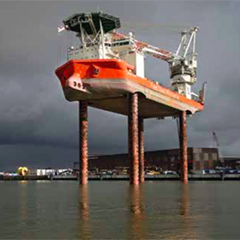Fred. Olsen Windcarrier prepares for the next generation of offshore wind farms. Since the earliest offshore wind farm was installed just over 20 years ago, the offshore wind industry has been characterised by continuous improvement and innovation as firms at all junctures along the supply chain have leapt at the challenge to contribute to reducing the cost of wind energy.
Turbines have grown from a mere 450 kilowatts (kW), as was installed at Vindeby in Denmark in 1991, to 8 megawatt (MW) prototypes moving into production and with 10MW versions on the drawing board.
The increase in turbine capacity, accompanied by the fact they are also becoming far heavier, with larger rotor diameters and increased hub heights, has led to the need for suppliers to turbine manufacturers to look at how they can best meet their customers’ requirements.
The next generation of offshore wind farms will also be further from shore than those now in operation. This combined with the new larger turbines, means installation equipment has to adapt and stay one step ahead. Specifically, for offshore installation companies, it is imperative that their vessels are capable of meeting the needs of future projects.
Norwegian headquartered Fred. Olsen Windcarrier, which provides tailored transport, installation and maintenance services to the offshore wind industry, recognised this requirement early on. The company boasts more than 167 years of marine and offshore experience and knowledge so engineering to new standards is part of its heritage.
Key to the company’s readiness for upcoming projects was ensuring their two specialist 132 metre jack-up vessels will be set for the foreseeable future.



























